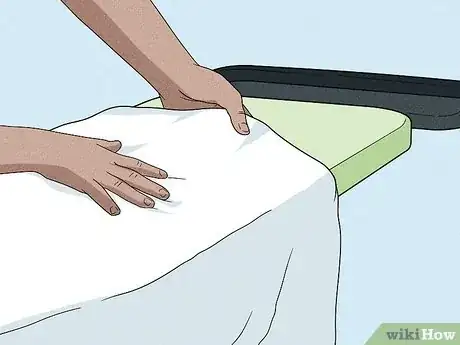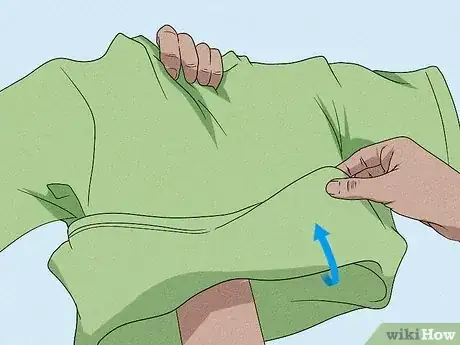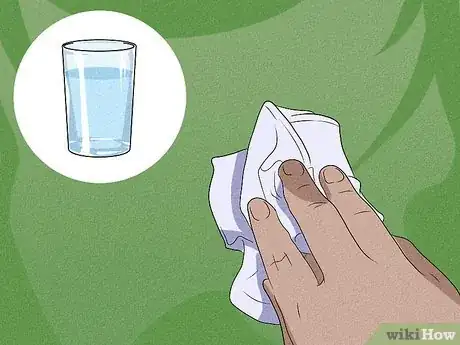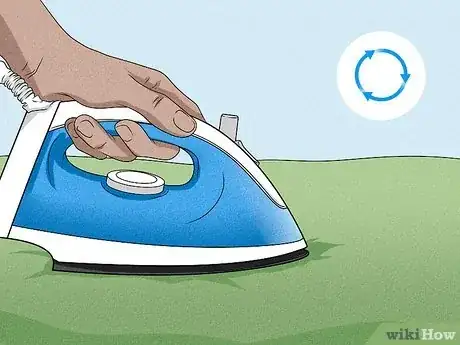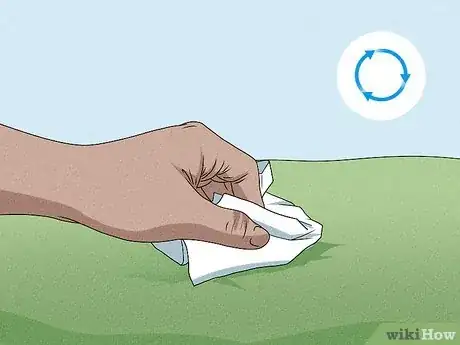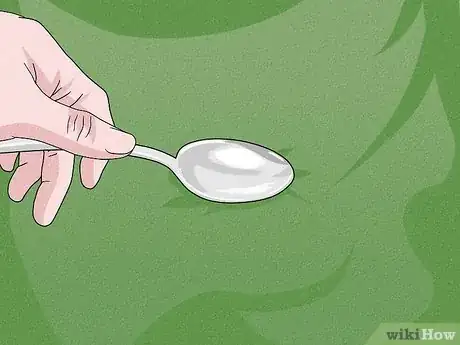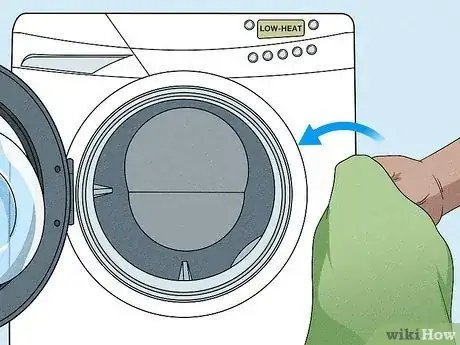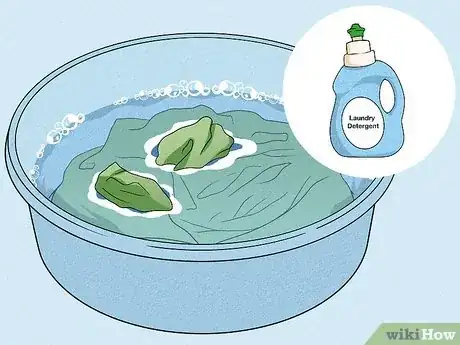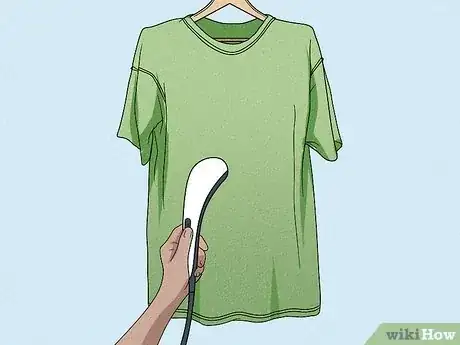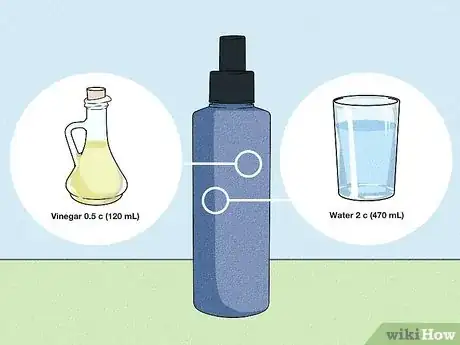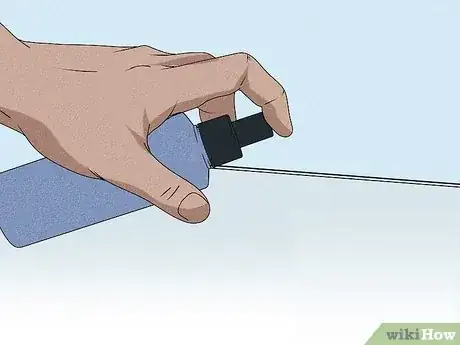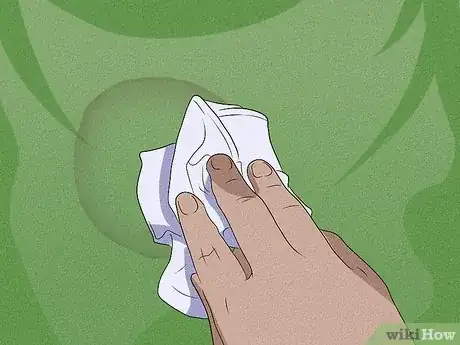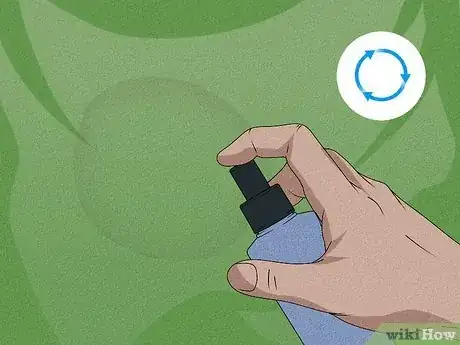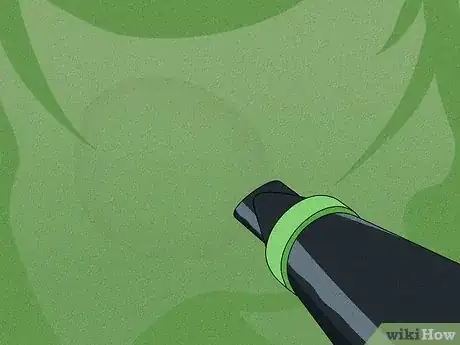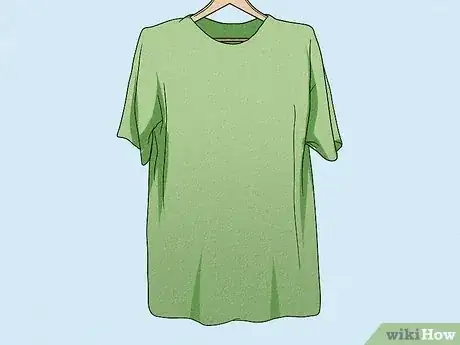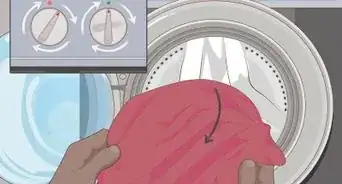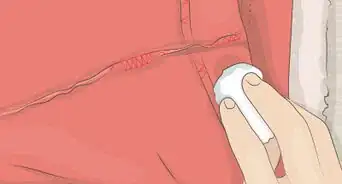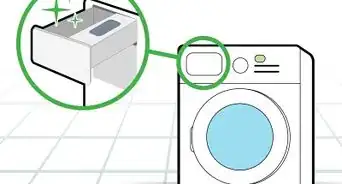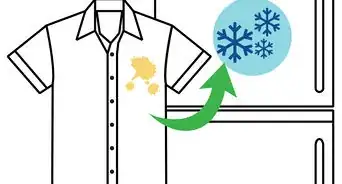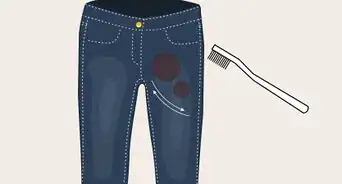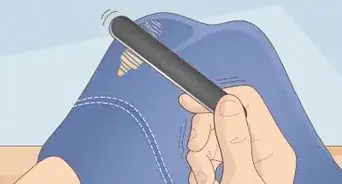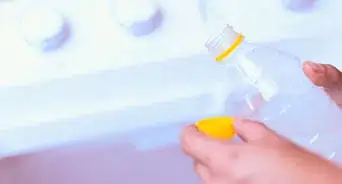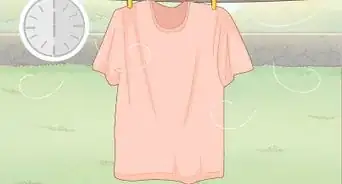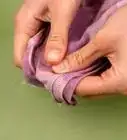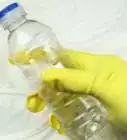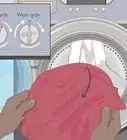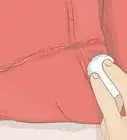This article was co-authored by Safir Ali and by wikiHow staff writer, Dan Hickey. Safir Ali is the Co-Founder and CEO of Hamper Dry Cleaning and Laundry, a startup in Houston, Texas reinventing the laundry industry. With over six years of experience launching and operating Hamper, Safir specializes in innovative ways to simplify dry cleaning using the experience from his family's business. Safir holds a Bachelor’s degree in Business Administration and Management from Texas A&M University. Hamper offers 24/7 on-demand dry cleaning and laundry through delivery and kiosk services. Hamper has been featured on the Houston Rockets, Station Houston, the Houston Business Journal, BBVA, Yahoo Finance, and Innovation Map.
There are 12 references cited in this article, which can be found at the bottom of the page.
This article has been viewed 211,039 times.
Water is a key ingredient to fighting most stains, so what do you do when it’s water that’s making the stains? When water contains lots of minerals or impurities, it can leave spots or rings on any fabric it comes into contact with. Thankfully, these stains are typically light and come out fairly easily. In this article, we’ll walk you through how to safely remove pesky water stains from your clothes, upholstery, and carpet so you’ll never have to fret over them again. If you’re ready to get cleaning, keep reading!
Things You Should Know
- Put stained clothing or fabric face down on a towel on an ironing board. Dampen the stain and iron it dry, repeating until the stain lifts completely.
- For light stains, machine wash or steam clothes and fabrics that can handle heat. Hand wash delicate fabrics like silk.
- Spray or dab stains on upholstery and carpet with a cleaning solution of water and distilled white vinegar. Blot dry and repeat until the stain is gone.
Steps
Ironing Stains out of Clothes & Fabric
-
1Lay a lint-free cleaning cloth or towel on an ironing board. Choose a white or light-colored towel so no color bleeds through onto your garment. Lay the towel flat so it can absorb excess liquid more efficiently and your iron glides smoothly.[1]
- Use this method on any clothing fabric that can be ironed, including polyester, canvas, cotton, chenille, modal, tweed, satin, or linen.[2]
- Do not iron velvet, suede, spandex, muslin, or leather.
- In addition to clothing, use this method for curtains, bedding, or other fabrics you can move onto an ironing board.
-
2Turn the garment inside out and lay the stain face down on the towel. Make sure the entire spot (or spots) are making contact with the towel. If the water stain isn’t visible after you lay the garment down, pick it back up and make a mental note of where it is.[3]Advertisement
-
3Dampen the stain with distilled water and a lint-free or microfiber cloth. Dip your clean cloth in the water and dab at the stain until it’s damp (not saturated). If the garment looks soaked, press on it with your hands so the towel underneath absorbs some of the water.[4]
- Use distilled water to prevent depositing additional minerals to your water stain (especially if your tap water is hard).[5]
- Lint-free or microfiber cloths won’t leave any lint or fuzz on your clothes.[6]
-
4Iron over the dampened stain until it’s completely dry. Fill your iron with distilled water or ironing water. Turn the iron on to a heat setting that’s safe for the fabric—check the tag for ironing instructions if you’re not sure. Then iron over the spot until it’s totally dry, never letting the iron sit in one place.[7]
- Keep the iron moving at all times to prevent burning your clothes or creating an iron stain.
-
5Repeat dampening and ironing until the stain is gone. If the stain remains after your first go with the iron, shift the garment so the stain is laying on a dry part of the towel. Dampen it again with a clean cloth and water, then iron it dry. Keep repeating until the stain has almost entirely disappeared.[8]
-
6Rub any remaining stain marks with the back of a clean spoon. If you notice a slight ring around the stain, turn the garment right side out and lay it flat on a dry part of the ironing board. Grab a spoon and firmly rub the stain in circular motions to smooth out the fabric and minimize the stain’s appearance.[9]
- If you don’t have a spoon on hand, use your fingers instead. Run them under hot water and then rub the stain in circular motions.[10]
- The rubbing motion slightly stretches out the clothing fibers, which makes the remaining stain seem less obvious.
Laundering Clothes with Light Stains
-
1Put washable clothes through a regular wash cycle. Pretreat the water spots with a gentle stain remover and run the clothes through the washing machine at a fabric-safe temperature. Use extra detergent or add a liquid water softener if you have hard water (the dissolved minerals make it harder for detergent to lather).[11]
- If the stain is discolored from mineral deposits in the water, pretreat it with a rust stain remover for clothing.
- Check the clothing label to see the recommended water temperature for washing.
- Avoid using bleach for water stains, especially if the stain is discolored. It’s hard on fabric and may aggravate the discoloration.
-
2Hand wash silk and other delicate fabrics. Mix a silk-safe laundry detergent in a bucket of lukewarm water. Soak the garment and gently rub at the stains with your fingers. When you’re finished, squeeze the excess water out of the fabric (no wringing or twisting). Then rinse with lukewarm water until all detergent residue is gone.[12]
- If you can't get all the soap out of the fabric, add 1 tablespoon (15 mL) of distilled white vinegar to the water to dissolve the detergent.
- To dry, lay the fabric flat on a clean towel and roll it up to press out the water.
-
3Steam stains out of any fabric except suede, waxed jackets, or plastic. Hang your garment inside out on a hanger and grab a clothes steamer (or an iron on the steam setting). Steam the stain from top to bottom, then flip the garment right-side out and steam again.[13]
- Keep an eye on the stain while you work—it will disappear after a few minutes.
- Let the garment air dry and cool off before wearing it.[14]
Using Vinegar on Upholstery & Carpet
-
1Mix distilled white vinegar and water in a spray bottle. Combine 0.5 c (120 mL) vinegar and 2 c (470 mL) water for upholstery or a 50/50 mix for carpet. If your tap water is hard, use distilled water to prevent minerals getting deposited into your upholstery or rug. Vinegar is a mild cleaner and it is safe to clean all fabric couches, other upholstered furniture, and carpet with it.[15]
- If you don’t have a spray bottle, dampen a clean microfiber cloth in the vinegar solution.[16]
- Water stains don’t usually need concentrated cleaners, so a light vinegar solution is an easy and safe way to remove them.
-
2Test the vinegar solution on an inconspicuous spot. Spray or dab a small amount to a spot like the back corner of a couch or the underside of a fabric chair and wait a few minutes for it to dry. If there’s any staining or discoloration, dump the vinegar solution and use plain distilled water instead.[17]
- If there’s no visible mark, the vinegar solution is good to go!
-
3Spray the stain lightly until the entire spot is covered. If your nozzle has multiple settings, turn it to the lightest one and gently mist the stain. Spray sparingly—if you saturate the fabric or carpet, you increase your chances of making the stain worse. Be cautious around the edges so that you’re only spraying the stained part of the fabric.[18]
- If you’re using a vinegar-soaked cloth, gently dab the entire stain until it’s damp with the cleaning solution, working from the outside of the stain inward.[19]
- If a carpet stain is old or discolored, work the solution into the carpet with your fingers for a minute or two and let it sit for up to 30 minutes.[20]
- If a carpet stain has dirt on top of it, dab it clean with a cloth and 1 c (240 mL) water and 1 tsp (4.9 mL) dish soap before spraying.[21]
-
4Rub the stain with a cloth or soft brush, then absorb the extra solution. Work from the outside of the stain inward using circular motions to keep the stain from spreading.[22] Rub gently to avoid damaging the fabric or wearing out the carpet fibers, but use a little more pressure in the center of the stain than the edges for the best results.[23]
- After you’ve rubbed the stain away, use a dry cloth or paper towels to blot away the remaining vinegar solution before it leaves another stain.[24]
- If a carpet stain is light, skip the scrubbing and just blot the area with a cloth and let it air dry. Most of the stain will lift with the absorbed liquid.[25]
-
5Repeat spraying and rubbing until the stain disappears. If the stain is still visible, mist or dab the area with more vinegar solution and gently rub it again. The stain might require multiple rounds if it’s old or if it’s discolored by minerals from hard water.[26]
- If you’re working on carpet, make sure the area dries completely before each repetition to prevent new stains or odors.[27]
-
6Dry the stain with a hair dryer on a cool setting. Absorb as much liquid as you can with a cloth, then grab a hair dryer. Use a cool setting (unless your fabric or carpet can handle heat) to blow dry the area quickly. Alternatively, point a fan at the furniture to speed up the drying time.[28]
- Using a hair dryer or a fan prevents mold growth and odor.
- Once a carpet patch dries, vacuum over it to ensure it’s clean.
-
7Finished.
Expert Q&A
Did you know you can get premium answers for this article?
Unlock premium answers by supporting wikiHow
-
QuestionHow do you get a water stain out of a couch?
 Safir AliSafir Ali is the Co-Founder and CEO of Hamper Dry Cleaning and Laundry, a startup in Houston, Texas reinventing the laundry industry. With over six years of experience launching and operating Hamper, Safir specializes in innovative ways to simplify dry cleaning using the experience from his family's business. Safir holds a Bachelor’s degree in Business Administration and Management from Texas A&M University. Hamper offers 24/7 on-demand dry cleaning and laundry through delivery and kiosk services. Hamper has been featured on the Houston Rockets, Station Houston, the Houston Business Journal, BBVA, Yahoo Finance, and Innovation Map.
Safir AliSafir Ali is the Co-Founder and CEO of Hamper Dry Cleaning and Laundry, a startup in Houston, Texas reinventing the laundry industry. With over six years of experience launching and operating Hamper, Safir specializes in innovative ways to simplify dry cleaning using the experience from his family's business. Safir holds a Bachelor’s degree in Business Administration and Management from Texas A&M University. Hamper offers 24/7 on-demand dry cleaning and laundry through delivery and kiosk services. Hamper has been featured on the Houston Rockets, Station Houston, the Houston Business Journal, BBVA, Yahoo Finance, and Innovation Map.
Professional Dry Cleaner
-
QuestionHow do you get water stains out of wood?
 wikiHow Staff EditorThis answer was written by one of our trained team of researchers who validated it for accuracy and comprehensiveness.
wikiHow Staff EditorThis answer was written by one of our trained team of researchers who validated it for accuracy and comprehensiveness.
Staff Answer wikiHow Staff EditorStaff Answer
wikiHow Staff EditorStaff Answer -
QuestionWhat about dry clean fabric?
 wikiHow Staff EditorThis answer was written by one of our trained team of researchers who validated it for accuracy and comprehensiveness.
wikiHow Staff EditorThis answer was written by one of our trained team of researchers who validated it for accuracy and comprehensiveness.
Staff Answer wikiHow Staff EditorStaff Answer
wikiHow Staff EditorStaff Answer
References
- ↑ https://www.thelaundress.com/blogs/clean-talk-blog/how-to-remove-water-stains
- ↑ https://www.magicofclothes.com/fabrics-that-you-can-and-cannot-iron/
- ↑ https://www.goodhousekeeping.com/home/cleaning/tips/a17314/stains-water-spots-may07/
- ↑ https://www.goodhousekeeping.com/home/cleaning/tips/a17314/stains-water-spots-may07/
- ↑ https://www.realsimple.com/home-organizing/cleaning/cleaning-with-distilled-water
- ↑ Safir Ali. Professional Dry Cleaner. Expert Interview. 15 September 2020.
- ↑ https://www.goodhousekeeping.com/home/cleaning/tips/a17314/stains-water-spots-may07/
- ↑ https://www.goodhousekeeping.com/home/cleaning/tips/a17314/stains-water-spots-may07/
- ↑ https://www.goodhousekeeping.com/home/cleaning/tips/a17314/stains-water-spots-may07/
- ↑ Safir Ali. Professional Dry Cleaner. Expert Interview. 15 September 2020.
- ↑ https://how2removestains.com/how-to-remove-water-stains-from-fabric/
- ↑ https://www.loveyourclothes.org.uk/tips/how-wash-silk
- ↑ https://www.reviewed.com/laundry/features/how-to-steam-your-clothes
- ↑ https://how2removestains.com/how-to-remove-water-stains-from-fabric/
- ↑ https://www.upscalelivingmag.com/how-to-remove-water-stains-from-fabric-sofa/
- ↑ https://how2removestains.com/how-to-remove-water-stains-from-upholstery/
- ↑ https://www.upscalelivingmag.com/how-to-remove-water-stains-from-fabric-sofa/
- ↑ https://www.upscalelivingmag.com/how-to-remove-water-stains-from-fabric-sofa/
- ↑ https://how2removestains.com/how-to-remove-water-stains-from-upholstery/
- ↑ https://www.bestcordlessvacuumguide.com/how-to-remove-old-stains-from-carpet-with-vinegar/
- ↑ https://tmqcarpetcleaning.com/cleaning-blog/how-to-remove-old-water-stains-from-carpet-dont-let-stains-settle/
- ↑ https://www.upscalelivingmag.com/how-to-remove-water-stains-from-fabric-sofa/
- ↑ https://how2removestains.com/how-to-remove-water-stains-from-upholstery/
- ↑ https://www.upscalelivingmag.com/how-to-remove-water-stains-from-fabric-sofa/
- ↑ https://www.bestcordlessvacuumguide.com/how-to-remove-old-stains-from-carpet-with-vinegar/
- ↑ https://how2removestains.com/how-to-remove-water-stains-from-upholstery/
- ↑ https://tmqcarpetcleaning.com/cleaning-blog/how-to-remove-old-water-stains-from-carpet-dont-let-stains-settle/
- ↑ https://www.goodhousekeeping.com/home/cleaning/tips/a17314/stains-water-spots-may07/
- ↑ https://www.realsimple.com/home-organizing/cleaning/cleaning-with-distilled-water
About This Article
In many cases, you can get water stains out of fabric by ironing the stained area. Lay a white, lint-free cloth or towel on an ironing board. Then, turn the stained item inside out and put it on top of the towel with the stain facing down. Dab a little distilled water on the stain with a clean microfiber cloth. Fill your iron with distilled water and iron the stained area until it is completely dry. Repeat this process as many times as you need to until the stain is gone. If you still see a light ring around the stain, rub it with your fingers or the back of a spoon, which will help minimize the stain’s appearance. For tips on what to do if the padding on your upholstery gets wet while you're removing the water stain, keep reading!
